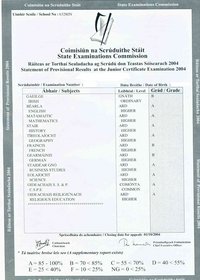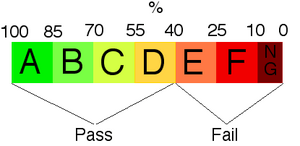Junior Certificate facts for kids
The Junior Certificate, often called the "Junior Cert", is an important school qualification in Ireland. It's given by the Department of Education and Skills. You get it after finishing the first part of secondary school, called the junior cycle. To get the Junior Cert, you need to do well in the Junior Certificate Examination. These exams are managed by the State Examinations Commission.
Contents
Understanding the Junior Certificate
The Junior Certificate is a key step in your education in Ireland. It helps you get a good, all-around education. This qualification is perfect if you plan to continue studying. It also helps if you decide to leave school after the junior cycle.
Who Can Take the Junior Cert?
To start the Junior Cycle, you usually need to be at least 12 years old by January 1st of that school year. You also need to have finished primary school. Most students take the Junior Cert exam after three years of study in secondary school.
What Subjects Do You Study?
Students typically take between 9 and 13 subjects for the Junior Cert. Important subjects like English, Irish, and Mathematics are always included. The Junior Cert is not for getting into college or university. For that, students usually take the Leaving Certificate Examination. This happens two or three years after finishing the Junior Cert.
How Are Junior Cert Grades Given?
Your results for the Junior Cert are shown as grades. These grades are based on the percentage you score in each subject. Here's how the grading works:
- 90 to 100% = Distinction
- 75 to 89% = Higher Merit
- 55 to 74% = Merit
- 40 to 54% = Achieved
- 20 to 39% = Partially Achieved
- 0 to 19% = Not Graded/NG
Support for Students with Learning Differences
If you have certain learning differences, like dyslexia or ADHD, you won't be marked down for spelling mistakes. This applies to subjects like English and Irish. These students get extra support and their exams are marked more fairly.
The Junior Cycle Student Award
In 2014, the Department of Education and Skills announced a new name for the Junior Certificate. It is now called the "Junior Cycle Student Award". This change helps show that it's a journey of learning, not just one exam.
Images for kids





